Research Article
CHOICE ARCHITECTS AS CHANGE AGENTS FOR OPEN-SOURCE TALENT DEVELOPMENT IN TOURSIM
3544
Views & Citations2544
Likes & Shares
INTRODUCTION
In a land where hospitality is at its peak, Goa still lacks open-source talent who are ready to advance their career in the tourism industry. The review of the literature indicates that Talent Development is associated with various disciplines of study ranging from management, economics, psychology, and marketing. It is observed that talent development mandates thought processes, which emanates from an open-source talent, who are yet to be influenced by the corporate world. It involves a set of iterations an individual has with the self or the environment. This ultimately results in a change, a transition from one state to another; it also results in decision making. To this end, various models of change are also assessed. The study attempts to build a new theory based on the existing Force Field Theory of Change; however, the orientation is towards talent development in the tourism industry.
Research problem/Gap is: Lacuna of awareness of sustainable talent development opportunities and support systems among open-source talent in Goa is the major reason for the youth not to develop their talent through management education and not to choose careers in the tourism industry.
The research question for purpose of this paper is: What are the course attractors and course influencers along with support systems that create an opportunity to develop a sustainable open-source tourism-based talent pool in Goa?
LITERATURE REVIEW
Change management through education
Heraclitus [1]stated, “Nothing is permanent save change”. Change is an evolving influence and an inevitable element of both societal and organizational vitality, change constantly demands insight and adaptation skills. The qualifications of performers in the tourism sector are very important; this makes highly qualified executives and employees unquestionably essential. (Athanasios & Konstantinos, n.d.). For that matter, change may also be incorporated through career growth as (Goeldner & Ritchie, 2012) indicated that the labor-intensive tourism industry needs motivated people of all ages and backgrounds. Those who prepare themselves, maintain high energy, have a talent for working with people, and are dedicated to high-quality service will climb the career ladder to success.
Theoretical framework
Talent development works on the framework of Theory of Change where the focus is on key goals and outcomes achieved. The study of change has resulted in the development of many models, and scholars have associated it with organizations, and behaviors that bring about change in an individual; they can be also be eventually linked to talent development.
An organizational development perspective
Doyle (1998) asserted that the foundation of the company lies in the portfolio of their core capabilities, his study focused on core competence, and on the skills inherited. Lunch (1997) discussed Kanter, Stein, and Jick’s ‘big three’ model that includes: “Change Strategist”, “Change Recipients” and “Change Implementers” and all three require their specific levels of talent to mobilise changes. Martin (2001) based on Kotters and Schesinger’s change models introduced the ‘explicit plus implicit coercion’. Change, based on this strategy, depicts force and menace.
Behavioral change perspective
This discipline advocates that there are individuals charged with the task that can be thought of as “interventionists” whose goal is to design and implement programs or interventions that produce the desired behavioral changes. (Glanz, Lewis, & Rimers, 1990). Bandura (1986) developed the Social Cognitive Theory of Behavior Change which proposes that people are driven not by inner forces, but by external factors. Change in behavior is also seen in open-source talent who are given an opportunity to become interns in organizations. However, the interventionist has to create choices of internships to be offered to the open-source talent.
A combined perspective of Psychologist, Behavioral Economist, and Management Discipline
Though it’s tough to make people change, people do change, and they do so in a predictable way during the entire course of their lives (Hellervik, Hazucha, & Schnider, 1992). Force Field Analysis was developed by Kurt Lewin (1951) and is widely used to inform decision making, particularly in the plan and implementation of change management programmes in organizations. The force-field analysis framework is an effective way of capturing factors that both serve to accelerate, promote or enhance research uptake (driving forces) or decelerate, impede or actively undermine uptake (restraining forces) (Barakat,Waldman, & Varisco, 2014).
The secret of a good decision is to figure out whether the pros outweigh the cons before action is taken. (Swinton, 2015). However just an increase in the driving forces is not enough for change, Lewin suggested that change would be easier and last longer if the forces against change were reduced, rather than the forces for change are increased. A glance at the ‘Open Talent Economy’ framework reveals that open-source talent, have an open-relationship interaction, they are not hired by the organization, while they may play a vital role in providing suggestions towards the company’s product or services, talent management initiatives are absent and talent development activities may take place from the individuals side (Dias, Radha & Dias 2016).
Baumeyer (2016) emphasized the need to identify key players in decision making, recognise who is for and against the change, and influences those who are against the change. However, an influence with coercion does not work as effectively as a nudge. A ‘nudge’ entails ‘any aspect of the choice architecture that alters people’s behavior predictably without forbidding any options or significantly changing their economic incentives’ (Thaler & Sunstein, 2012).
People are subject to the bias which can lead to bad decisions, and this may lead to poor choices in health and wealth, if we understand the way people think it will be easier for them to make the best choices, for their families and society. There are ways to nudge people in the right direction without restricting their freedom of choice. A choice architect is a person who is responsible to organize the context in which people make decisions (Thaler & Sunstein, 2012). They have also discussed the concept of "Status Quo Bias", which is a fancy name for inertia. Individuals have a strong tendency to conform to the default position or status quo. They warn that the power of inertia should not be underestimated. However, this power can be harnessed and can be used in policymaking if it gives favorable results. Many times, it is assumed that the presence of choices will provide a good result. At times the status quo makes us default to things that we have been doing earlier.
HYPOTHESIS DEVELOPMENT
This study empirically tests the influence of a professional tourism course to advance a career in the tourism industry. The decision of the learner to pursue higher education. And the probability of joining the professional tour\ism course in the future. The hypothesis is built around awareness of the professional tourism course, which is created by the choice architect or the influencer. The hypothesis formulated are:
Hypothesis 1: The awareness of a professional course in tourism, influences students to opt for a career in the tourism industry.
Hypothesis 2: The awareness of a professional course in tourism influences the need to supplement graduation with a professional course.
Hypothesis 3: The awareness of the professional course in tourism influences the propensity to join a professional tourism course in the future.
METHODOLOGY
Objectives of the Descriptive Research
- To profile the respondents of open-source talent in the tourism industry.
- To identify if awareness of a professional course in tourism, influences students to opt for a career in the tourism industry.
- To identify if awareness of a professional course in tourism, influences the need to supplement graduation with a professional course.
- To identify if awareness of the professional course in tourism, influences the propensity to join a professional tourism course in the future.
- To list the choice elements that can act as a nudge factor that can influence decision to enrol for a professional course or change in behavior.
Research construct development stages
A descriptive research design has been used for this study. The construct of extrinsic talent development was conceptualized using theory and associated models. While the sub-dimensions were based on the pre-determined taxonomy associated with the construct (Table 1).
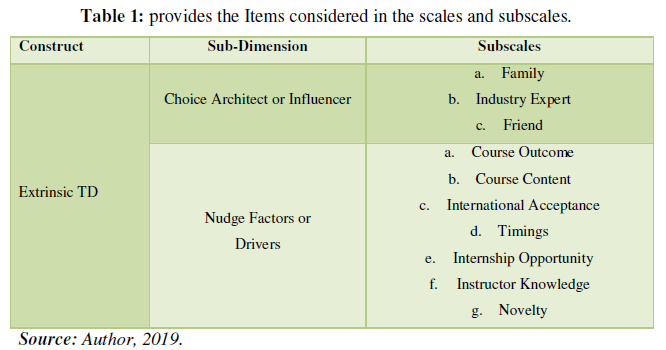
SAMPLE DESIGN
The questionnaire was administered using a convenience sampling method. When the population is dispersed across a large geographical region, researchers can opt for a convenience sampling technique for data collection (Farrokhi & Hamidabad, 2012). In a convenience sampling method, the sample is chosen based on the accessibility or proximity to the researcher (Etikan, 2016). The study involved both exogenous and endogenous talent development activities and the following criterion was adopted:
Criteria for Inclusion of Exogenous Talent Development Respondents
Education Qualification- Under Graduate, Discipline-Any, Age Group- 15-25 years.
Criteria for Exclusion
Limited to the colleges in Goa, India, Employees of the tourism industry Total Students 32,114 (MHRD Report), Sample Frame was 3000 after exclusion and inclusion. Distributed to 800 samples, error/precision level, and confidence of 95% with p
Justification of Sample Size
A simplified formula is used to calculate the sample size as prescribed by Yamane (1967:886). This formula was cited by 1529 scholarly articles.


Where: n= Sample Size, N= Population Size, e= Level of precision or Sampling Error More over sampling adequacy is tested using Kaiser-Meyer-Olkin and Barlett`s test of Sphericity.
Statistical Tests Used:
- Frequency and Percentages for profiling of open-source talent.
- Chi-square test to study the influences and decisions of open-source talent.
- Factor analysis to identify the external nudges of talent development.
Data analysis
Demographic profile of Open-Source Talent
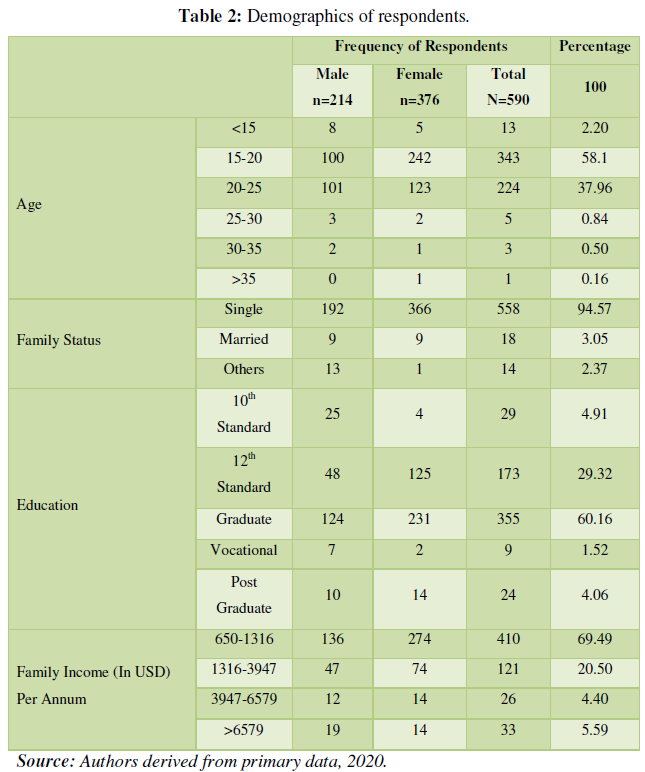

From Table 2 it is observed that 58.10% belong to the age group of 15-20, followed by 37.96% belonging to the age group of 20-25. Female respondents are at 53.72%, while male respondents are at 36.27%. The open-source talents are also single with the highest representation at 94.57%, graduates or those pursuing graduation are at 60.16%, the highest representation is of 69.49% from the family income group of USD 650-1316 per annum.
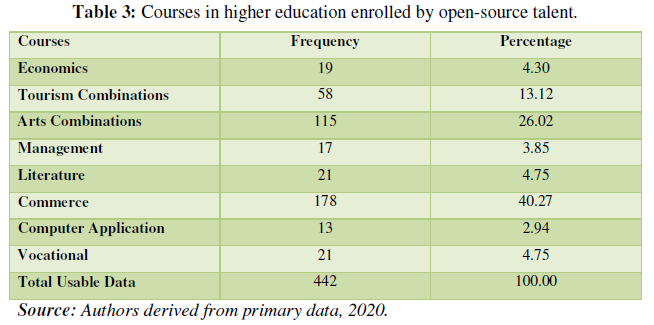

A quick look at (Table 3). displays that the highest representation is from Commerce at 40.27%, followed by Arts combination at 26.02%. It’s also interesting to note that students from other disciplines are also interested to pursue their education in the tourism industry.
Hypothesis testing
The three hypotheses were tested using chi-square test the results revealed are:
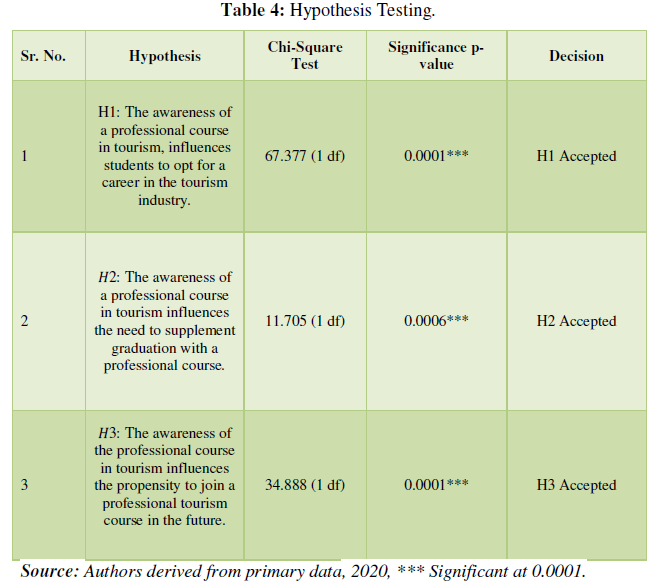

In Table 4 serial no. 1, reveals the Chi-squared equals 67.377 with 1, degrees of freedom. The two-tailed P-value is less than 0.0001**. The association between awareness of a professional tourism course and propensity to advance their career in the tourism industry is considered to be extremely statistically significant. Hence the hypothesis statement is accepted 𝐻1: The awareness of a professional course in tourism, influences students to opt for a career in the tourism industry is upheld through this test. Serial No. 2, Chi-square with Yates correction Chi squared equals 11.705 with 1 degree of freedom. The two-tailed P value= 0.0006**. The association between awareness of the professional tourism courses and the need to supplement their graduation with a professional course is considered to be extremely statistically significant. Hence the hypothesis statement 𝐻2: The awareness of a professional course in tourism influences the need to supplement graduation with a professional course holds good. Serial No. 3 Chi-squared equals 34.888 with 1 degree of freedom. The two-tailed P-value is less than 0.0001. The association between APTC and propensity to join a professional tourism course in the future is considered to be extremely statistically significant as indicated in Table 5. The hypothesis statement 𝐻3The awareness of the professional course in tourism influences the propensity to join a professional tourism course in the future is accepted.
The exploratory factor analysis revealed seven nudge factors, three course influencers and two course contributors as indicated in Table 5. The rotated component matrix has derived three dimensions the first dimension is related to attractive features of the course, which explains seven attributes under this dimension. The second dimension is the course influencer and is attributed to three factors. The third dimension is attributed to the external factors which influence students to take up a course related to tourism talent development. The reliability of the instrument used here is high at 80.7% which is good and tests 13 variables. The Kaiser-Meyer-Olkin Measure of sampling adequacy has a value of 0.868 which makes the sample adequate for testing, the chi-square is also high and significant at 0. 000.The total variance explains a total of three components or dimensions at 55.248% the base value is 0.5 or 50%.
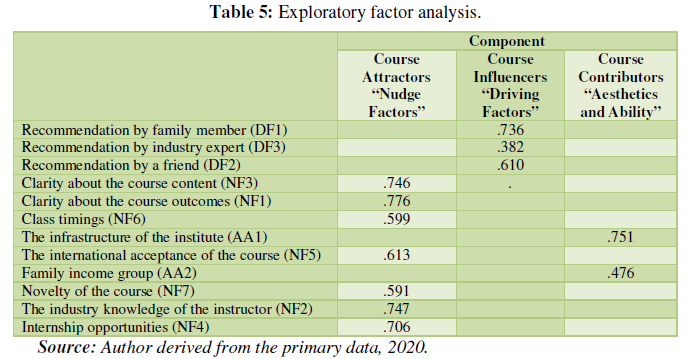

FINDINGS AND DISCUSSIONS
We observe that there are people who can enforce changes and ones who receive the change. This school of thought opines that change should be implemented through force. The study focuses on those people who can enforce changes however not with force as the study is inclined towards talent development outside the organization. While the behavioral change interventionist from the domain of psychology can be easily related to choose architects of the behavioral economist genre, their main aim is to make the change happen due to scientific methods and the provision of proper choices. However, all this does not easily happen due to the presence of inertia and the habits of people defaulting to their original status quo, clearly explained through Kurt Lewin's force field analysis, which to some extent is embedded in the theory of OD and believes in coercion, it can be countered by the nudge effect provided by choice architect.
As a choice architect, the following aspects of being part of the tourism industry were displayed to create a nudge effect, the global career opportunities, placement records, remuneration offered, global acceptability, perks offered in the aviation industry, uniforms. Apart from this the course features such as innovative pedagogy applied, and the opportunity to visit exotic locations was also discussed. This was done with the intent to nudge the open-source talent towards the myriads of opportunities available in the interdisciplinary study of tourism. To this end the survey captured the latent dimensions, which clearly indicate nudge factors, which act as course attractors and the support systems who influence a decision of the open-source talent and factors related to aesthetics and ability. Even though the survey was administered before applying the nudge the respondents chose the very factors that were being tested through the theory of change.
New theory development
Kurt Lewin's force field theory of change only focused on the two-dimensional aspects of opposite forces acting on each other to keep a person or organization or a person in inertia, however, if the third dimension of nudge is applied, it will provide choices to people without the use of force to change them, but will give them a free will to decide on their own. Thereby it affirms an alternative theory, “There are driving and opposing forces acting on an individual creating a state of inertia, a nudge in terms of “course attractors”, created by a choice architect, the “course influencers” which includes the support ecosystem, and “course contributors” through aesthetics and ability can significantly influence an individual as it offers various choices and creates awareness about career opportunities and thus help an open-source talent to make career change decisions in the absence of force or coercion”.
CONCLUSION
It is interesting to note that the open-source talent, automatically gets influenced by many factors in the process of talent development. Further study is indicated to prove if the theory can be generalized to the talent development initiatives of certified tourism professionals who work with the tourism industry which can be termed as “Talent Enhancement”. An attempt can be also made to identify the reasons that cause people to deviate from this industry after being certified which can be termed as “Talent Abandonment”. Thus, will lead to the examination the all three aspects of talent economy which relates to Talent Development process undertaken by an open-source talent, leading to Talent Enhancement which happens within an organization, and Talent Abandonment an exit which can result due to a failure to find a right fit in the tourism industry.
[1]A Greek philosopher of Ephesus who was also known as the weeping philosopher: Source Stanford Encyclopedia of Philosophy.
- Athanasios, T., & Konstantinos, S. (2019). The scope of change strategy in tourism enterprises. Journal of Tourism Research. Available online at: http://jotr.eu/index.php/tourism-management/20-the-scope-of-change-strategy-in-tourism-enterprises#_ftn1
- Bandura, A. (1986). Social Foundations of Thought and Action. Englewood Cliffs New Jersey Prentice Hall.
- Barakat, S., Waldman, T., & Varisco, A. (2014). Understanding Influence, The use of state building research in British Policy. Ashgate Publishing Company England.
- Dias, V.C.S., Radha, P., & Dias, B.V. (2016). Emerging Trends in the Talent Economy A special emphasis on Talent Development and Talent Management. Anushandhan, Interdisciplinary Research Journal 6(1), 76.
- Doyle, P. (1998). Marketing Management and Strategy 2nd Edition Prentice Hall Europe.
- Etikan, I. (2016). Comparison of Convenience Sampling and Purposive Sampling. American Journal of Theoretical and Applied Statistics 5(1), 1-4.
- Farrokhi, F., & Hamidabad, A.M. (2012). Rethinking Convenience Sampling Defining Quality Criteria. Theory and Practice in Language Studies 2(4), 784-792.
- Glanz, K., Lewis, F.M., & Rimers, B.K. (1990). Health Behavior and Health Education: Theory, Research, and Practice. San Francisco CA JosseyBass.
- Goeldner, C.R., & Ritchie, J.R.B. (2012). Tourism Principles Practices Philosophies. John Wiley & Sons Inc Hoboken New Jersey.
- Hellervik, L.W., Hazucha, J.F., &Schneider, R.J., (1992). Behaviour change Models, methods and a review of the evidence in M.D. Dunnettte& L.M. Houghs (Eds). Handbook of Industrial and Organizational psychology 823-895.
- Baumeyer, K.K. (2016). Force field analysis change model. Available online at: http://study.com/academy/lesson/kurt-lewins-force-field-analysis-change-model.html
- Lewin, K. (1951). Field Theory in Social Science New York Harper and Row.
- Lunch, R. (1997). Corporate Strategy Pitman Publishing London UK.
- Swinton, L. (2015). Kurt Lewins Force Field Analysis Decision Making Made Easy. Available online at: http://www.mftrou.com/support-files/lewins-force-field-analysis.pdf
- Thaler, H.R., & Sunstein, C.R. (2012). Nudge Improving decisions about health wealth and happiness. Penguin UK.
- Yamane, T. (1967). Statistics An Introductory Analysis, 2nd Ed New York Harper and Row.


